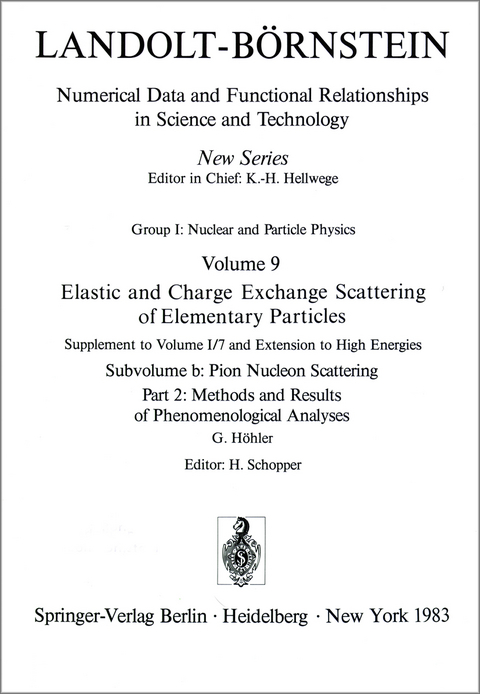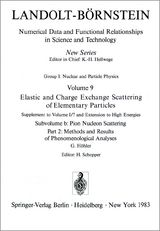Methods and Results of Phenomenological Analyses / Methoden und Ergebnisse phänomenologischer Analysen
Springer Berlin (Verlag)
978-3-540-11282-2 (ISBN)
- Keine Verlagsinformationen verfügbar
- Artikel merken
2.0 Introduction.- 2.1.1 General remarks on partial wave and amplitude analyses.- 2.1.3 Inelastic partial wave analysis - the continuum ambiguity.- 2.1.4 Classification of partial wave analyses.- 2.1.5 The SACLAY and CERN phase shift analyses.- 2.1.6 The analysis LONDON 73 ("CBC").- 2.1.7 The Karlsruhe-Helsinki analyses KH 78 and KH 80.- 2.1.8 The analysis LENINGRAD 78 and the SIN analyses.- 2.1.9 The Carnegie-Mellon-Berkeley analysis (CMU-LBL 79).- 2.1.10 New energy-dependent analyses.- 2.1.11 BARRELETs method.- 2.1.12 The analysis HENDRY 80.- 2.1.13 (pi-)p scattering near the eta-production threshold.- 2.1.14 The tail of high partial waves.- 2.1.15 Amplitude analyses without dispersion constraints.- 2.1.16 Amplitude analyses with dispersion constraints.- 2.1.17 Electromagnetic corrections.- 2.2.1 pi N forward amplitudes from total cross sections and dispersion relations.- 2.2.2 pi N partial wave amplitudes.- Fig. 2.2.1 - 33.- Table 2.2.2.1: KH 78 analysis.- Table 2.2.2.2 - 3: KH 80 analysis.- Table 2.2.2.4 - 5: CMU-LBL and SIN analyses.- 2.2.3 Invariant amplitudes.- 0.00 - 0.76 GeV/c.- 0.78 - 6.00 GeV/c.- Table 2.2.3.2: Below threshold.- 2.2.4 s-channel helicity amplitudes.- Table 2.2.3.3: At fixed scattering angle.- 2.3.1 Differential cross sections.- Fig. 3.1.1 - 4.- Table 2.3.1.2: Decomposition in the presence of Coulomb effects.- Table 2.3.1.1: Reconstructed from the KH solution.- Table 2.3.1.3: Legendre expansion.- 1.- 2.- 2.4.1.1 The notion of a resonance.- 2.4.1.2 Parametrizations of resonances.- 2.4.1.3 Results for the parameters of nucleon resonances.- 2.4.1.4 Nucleon resonances in other reactions than pi N -> pi N.- 2.4.1.5 Models for nucleon resonances.- 2.4.1.6 Degeneracy of the complex pole positions.- 2.4.2 Meson-nucleon coupling constants.- 2.4.3Zero trajectories.- 2.4.4 The saturation of isospin bounds.- 2.4.5 Invariant amplitudes in the unphysical region and near threshold.- Fig. 4.6.1 - 2.- Table 2.4.6.1: Partial wave amplitudes.- 2.4.6.2 pi pi-scattering phase shifts.- 2.4.6.3 Extrapolation of pi pi N anti-N partial waves to t > 0.- 2.4.7 Low energy expansions.- 2.5.1 Low-energy models for the pion-nucleon system.- 2.5.2 Electromagnetic nucleon and pion form factors.- 2.5.3 Two-pion exchange in nucleon-nucleon scattering.- 2.5.4 anti-N N pi pi amplitudes at t > 4m{2}.- 2.6.2 The Coulomb interference region.- 2.6.3 Diffraction scattering: fits to the data and amplitude analysis.- 2.6.3.1 The shape of the diffraction peak.- 2.6.3.2 The momentum dependence of (C+) and of the slope of Im(C+).- 2.6.3.3 The partial wave decomposition of the diffraction peak.- 2.6.3.4 The inelastic overlap function.- 2.6.3.5 A high energy approximation of the impact parameter formalism.- 2.6.3.6 pp-scattering amplitudes in the ISR range.- 2.6.3.7 Elastic scattering at large t.- 2.6.3.8 The isospin even s-channel helicity flip amplitude.- 2.6.4.1 The CHOU-YANG model.- 2.6.4.2 The CHENG-WU model.- 2.6.4.3 Geometrical scaling.- 2.6.4.4 The VAN HOVE model for the inelastic overlap function.- 2.6.4.5 Other s-channel models.- 2.6.4.7 General remarks on t-channel models.- 2.6.4.8 HARARIs dual absorptive model.- 2.6.4.9 Recent work on Regge pole phenomenology.- 2.6.4.10 LIPKINS two-component pomeron.- 2.6.4.11 Diffraction in electromagnetic processes.- 2.6.4.12 The transition to the wide-angle region.- 2.6.4.13 Theoretical papers on diffraction scattering.- 2.6.5 Near-forward charge-exchange scattering.- 2.6.6 Wide-angle scattering.- 2.6.7 Near-backward scattering.- 2.6.8 Total elastic and charge-exchange cross sections.- 2.6.9 Survey index for the experimental data in the near-backward u-range.- A - I.- J - Z.- Addendum: A - S.- A - C.- C - H.- H - N.- N - Z.- Addendum: A - S.- 3.3 List of pion-nucleon scattering experiments.- 1 Kinematics.- 2 Scattering amplitudes.- 3 Expansions of scattering amplitudes.- 4 Measurable quantities.- 5 Unitarity.- 6.1 Behaviour of invariant amplitudes under symmetry operations.- 6.2 The MANDELSTAM representation.- 6.3 Fixed-t dispersion relations.- 6.4 Forward dispersion relations.- 6.6 Fixed-u and fixed-s dispersion relations.- 6.7 Hyperbolic dispersion relations.- 6.8 Fixed center-of-mass angle dispersion relations.- 6.10 Fixed-nu dispersion relations.- 7 Analytic properties of partial wave amplitudes.- 8 Low energy models.- 9 Regge models.- 10 Isospin bounds.- 11 Electromagnetic nucleon and pion form factors.- 12 References.
| Erscheint lt. Verlag | 1.12.1982 |
|---|---|
| Reihe/Serie | Elementary Particles, Nuclei and Atoms | Landolt-Börnstein: Numerical Data and Functional Relationships in Science and Technology - New Series |
| Zusatzinfo | 601 p. |
| Verlagsort | Berlin |
| Sprache | englisch; deutsch |
| Gewicht | 1775 g |
| Themenwelt | Naturwissenschaften ► Physik / Astronomie ► Allgemeines / Lexika |
| Naturwissenschaften ► Physik / Astronomie ► Atom- / Kern- / Molekularphysik | |
| Naturwissenschaften ► Physik / Astronomie ► Hochenergiephysik / Teilchenphysik | |
| Naturwissenschaften ► Physik / Astronomie ► Quantenphysik | |
| Schlagworte | CERN • cross section • Elastic scattering • Isospin • Meson • Pion-Nukleon-Streuung • scattering • Streuamplitude |
| ISBN-10 | 3-540-11282-0 / 3540112820 |
| ISBN-13 | 978-3-540-11282-2 / 9783540112822 |
| Zustand | Neuware |
| Haben Sie eine Frage zum Produkt? |
aus dem Bereich




